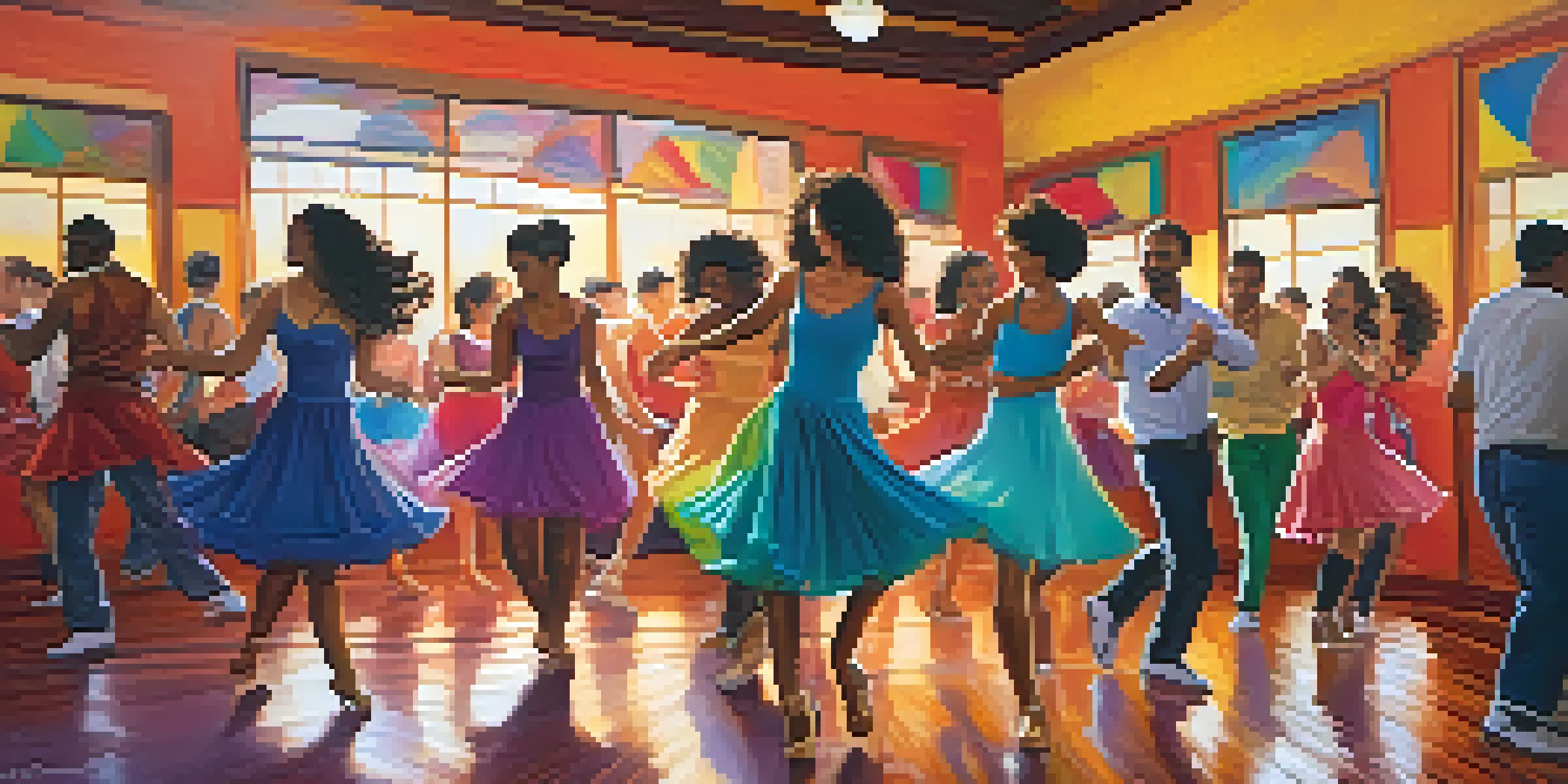The Link Between Dance, Physical Fitness, and Global Health

Understanding Dance as a Form of Physical Fitness
Dance is more than just a captivating performance; it’s a powerful form of physical fitness. Engaging in dance incorporates various physical movements that enhance cardiovascular health, flexibility, and strength. Whether it's ballet, salsa, or hip-hop, each style offers unique benefits that can transform your body and improve overall well-being.
Dance is the hidden language of the soul.
For instance, a dance class can burn as many calories as a high-intensity workout, making it a fun alternative to traditional exercise routines. The rhythm and flow of dance not only keep you moving but also elevate your heart rate, promoting better circulation. This enjoyable approach to fitness makes it easier for people to stick with their exercise regimen.
Moreover, dance encourages social interaction, which can further enhance motivation and commitment to a healthy lifestyle. When individuals dance together, they create a supportive community that fosters accountability and engagement, ultimately contributing to better health outcomes.
The Mental Health Benefits of Dancing
Dancing is not only beneficial for physical health but also plays a significant role in mental health. Engaging in dance can help reduce stress, anxiety, and depression, acting as a natural mood booster. The joy of moving to music releases endorphins, often referred to as the 'feel-good' hormones, which can brighten your day and lift your spirits.

Additionally, dance fosters creativity and self-expression, allowing individuals to channel their emotions through movement. This form of expression can be particularly therapeutic for those struggling with mental health challenges, providing a safe outlet to explore feelings. The combination of physical activity and creative expression creates a powerful tool for enhancing emotional well-being.
Dance Boosts Physical Fitness
Engaging in various dance styles can enhance cardiovascular health, flexibility, and strength while providing a fun alternative to traditional workouts.
Furthermore, participating in group dance activities can combat feelings of isolation and loneliness. Being part of a dance community can build lasting friendships and provide a sense of belonging, which is crucial for mental health support.
Global Health Initiatives and Dance Programs
Across the globe, various health initiatives have recognized the value of dance in promoting wellness. Programs that incorporate dance are being implemented to improve health outcomes in communities, particularly in underserved areas. These initiatives often focus on encouraging active lifestyles and fostering a sense of community through dance.
To touch, to move, to inspire. This is the true gift of dance.
For example, organizations in countries facing high obesity rates have started community dance classes to promote physical activity in a fun and engaging way. These classes not only motivate participants to move but also educate them about the importance of fitness and healthy living. By integrating dance into public health strategies, we can reach more people and inspire them to prioritize their health.
Moreover, dance programs can address cultural barriers to fitness by embracing local dance styles and traditions. This cultural relevance makes participation more appealing and accessible, reinforcing the idea that fitness can be enjoyable and part of one's lifestyle.
Dance as a Tool for Cultural Connection
Dance serves as a universal language that transcends cultural boundaries, connecting people through movement. In a world that often feels divided, dance brings individuals together, fostering understanding and appreciation for different cultures. This connection is not just enriching on a personal level; it has broader implications for global health.
By participating in dance from various cultures, individuals can learn about the traditions and histories that shape different communities. This cultural exchange can lead to increased empathy and collaboration in addressing global health challenges. For instance, when communities share their dance traditions, they also share insights into their health practices and wellness strategies.
Mental Health Benefits of Dance
Dancing helps reduce stress and anxiety, acting as a natural mood booster through the release of endorphins and promoting self-expression.
Furthermore, cultural dance events often promote community health initiatives, encouraging participants to engage in fitness while celebrating their heritage. This blend of culture and fitness can create a powerful movement for positive health changes in society.
The Role of Technology in Dance Fitness
In today's digital age, technology is revolutionizing how we engage with dance and fitness. Online platforms and mobile apps make it easier than ever to access dance classes from the comfort of your home. Whether you’re a beginner or an experienced dancer, these resources provide a flexible way to stay active and learn new skills.
Additionally, virtual dance classes have connected people from all over the world, creating a diverse community of dancers. This global connection fosters collaboration and motivation, as participants share their experiences and support one another. The ability to dance with others, even from afar, enhances the sense of community that is so vital for maintaining motivation in fitness.
Moreover, technology can track progress and provide personalized feedback, helping individuals stay accountable to their fitness goals. By utilizing these tools, dancers can enhance their skills while promoting a healthy lifestyle, making dance fitness more accessible to everyone.
Dance and Its Impact on Physical Health Worldwide
The impact of dance on physical health can be seen worldwide, with countless studies showcasing its benefits. From improving cardiovascular health to promoting balance and coordination, dance is a multifaceted approach to wellness. Countries that integrate dance into their cultural practices often report better health outcomes among their populations.
Programs that emphasize dance as a form of exercise have been successful in reducing health risks associated with sedentary lifestyles. For example, countries with strong dance traditions tend to have lower obesity rates and higher physical activity levels. This correlation highlights the potential for dance to serve as a preventative measure against various health issues.
Community and Cultural Connection
Dance serves as a universal language that fosters cultural understanding and community engagement, enhancing overall health and well-being.
Furthermore, the global reach of dance makes it an excellent tool for public health campaigns. By promoting dance as a fun and effective way to stay fit, health organizations can engage more people in physical activity, leading to healthier communities.
Incorporating Dance into Everyday Life for Better Health
Integrating dance into your daily routine doesn’t have to be complicated. Simple activities like dancing while cooking, taking a dance break at work, or joining a local dance class can make a significant difference in your physical fitness. The key is to find joy in movement, which will naturally encourage a more active lifestyle.
For those who may feel intimidated by formal dance classes, remember that any movement counts! Whether you enjoy free-styling in your living room or participating in a community dance event, every little bit contributes to your health. The goal is to make dance a regular part of your life, creating a sustainable and enjoyable fitness habit.

Additionally, inviting friends or family to join you can enhance the experience. Having a dance partner not only makes it more fun but also helps build a supportive network that encourages everyone to stay active and healthy together.